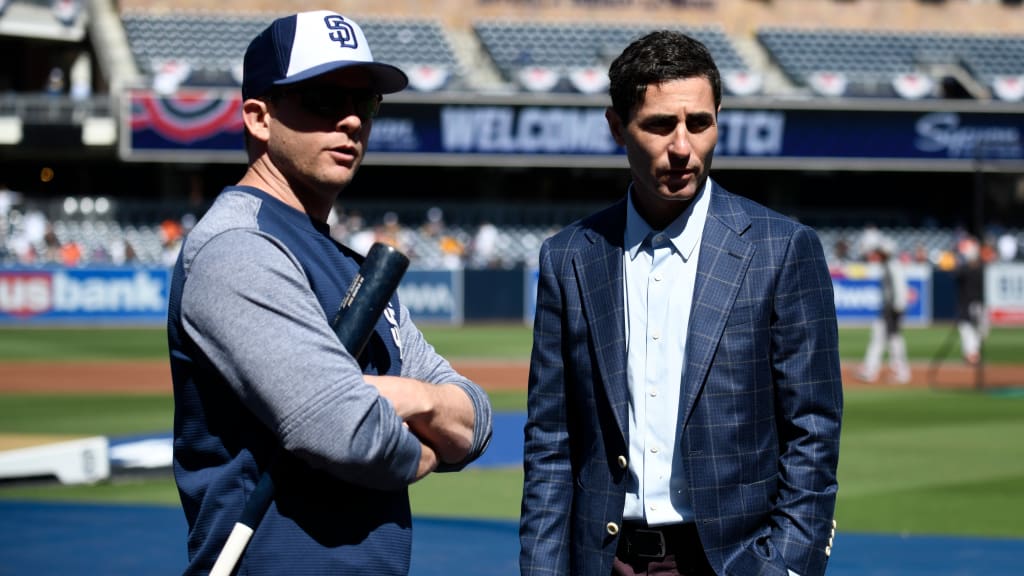
SAN DIEGO -- The Trade Deadline is just over two weeks away, and there might not be a team in baseball with more options than the Padres.
San Diego owns the sport's top-ranked farm system. It owns controllable big league pieces. It's lingering on the fringes of contention in a season that could seemingly go in two directions.
Expect general manager A.J. Preller to take full advantage of those options. With a young team on the rise, his hand won't be forced. He doesn't need to buy. He doesn't need to sell. But he could easily end up doing both.
Here’s a look at the four directions in which the Padres might steer ahead of the Deadline.
1. The case to buy
For the most part, Preller and the Padres have made it clear that they aren't very interested in acquiring rental pieces. If they're going to add at the Deadline, they're going to be shopping for players under contract through at least 2020 -- and preferably '21.
In that regard, the Padres wouldn't be buying merely for the 2019 stretch run. They'd be buying to set themselves up for the future as well. If Preller were to land, say, Noah Syndergaard (which seems unlikely at this point), he'd be setting his club up for a run in '19. But perhaps more importantly, he'd solidify the rotation of the future as well.
It would cost prospects, but the Padres have a lot of those. They've got arguably the deepest farm system in baseball. For a young team with virtually every player set to return next season, perhaps there's an added benefit to a playoff race this season -- even if it doesn't result in a trip to the postseason.
2. The case to sell
The 2019 Padres are a far cry from being a complete team. Sure, they're in the National League Wild Card mix right now. But with a thin rotation, a shaky bullpen and several holes in the lineup, it's worth wondering how sustainable their postseason push is.
All along, 2020 seemed like the year the Padres would take their step forward to contender status. Theoretically, that leaves this summer as the last chance for the them to truly bolster their long-term future.
San Diego will need to determine whether a 32-year-old reliever like Kirby Yates, who is under contract through 2020, is part of its long-term plan. It'll need to figure out if its corner-outfield group is deep enough to deal one of the big names.
Then, Padres would need to ask themselves: If we can acquire a young pitcher with future-ace potential or a long-term center-field solution, is it worth it?
3. The case to buy and sell
Right now, this is the camp the Padres find themselves in, according to people familiar with the team's discussions. The club is weighing both sides -- and doing so with the distinct possibility of making moves that veer in both directions.
The strategy isn't as counterproductive as it might seem. Say the Padres could fetch a mid-level prospect for Craig Stammen. Say the Padres could off-load Wil Myers' salary (or at least some of it). They'd probably be wise to sell.
But those types of moves wouldn't preclude Preller from becoming a "buyer" in the market for a big-name starter. Heck, the Padres could even trade Yates and still consider themselves buyers -- though it would weaken their bullpen significantly, and they'd become buyers with an eye on 2020 instead.
4. The case to hold
The Padres aren't approaching the Deadline with the goal of standing pat. But given the roster composition, it's a nice fallback option. The Padres don't need to make any moves. Among meaningful contributors, only Stammen is a free agent after this season. Only Yates is a free agent after 2020.
The Padres have an exciting group of young hitters that should get better over the next few seasons. They've got a pitching staff that might become very good once prospects like MacKenzie Gore and Luis Patino arrive.
In the past, Preller has set a notoriously high price tag on his own players. If it's met, he's willing to deal. If it isn't, well, why would he? The Padres seemingly have a good thing going. If they can't get better at the Deadline, there's no need to move pieces around and get worse.
